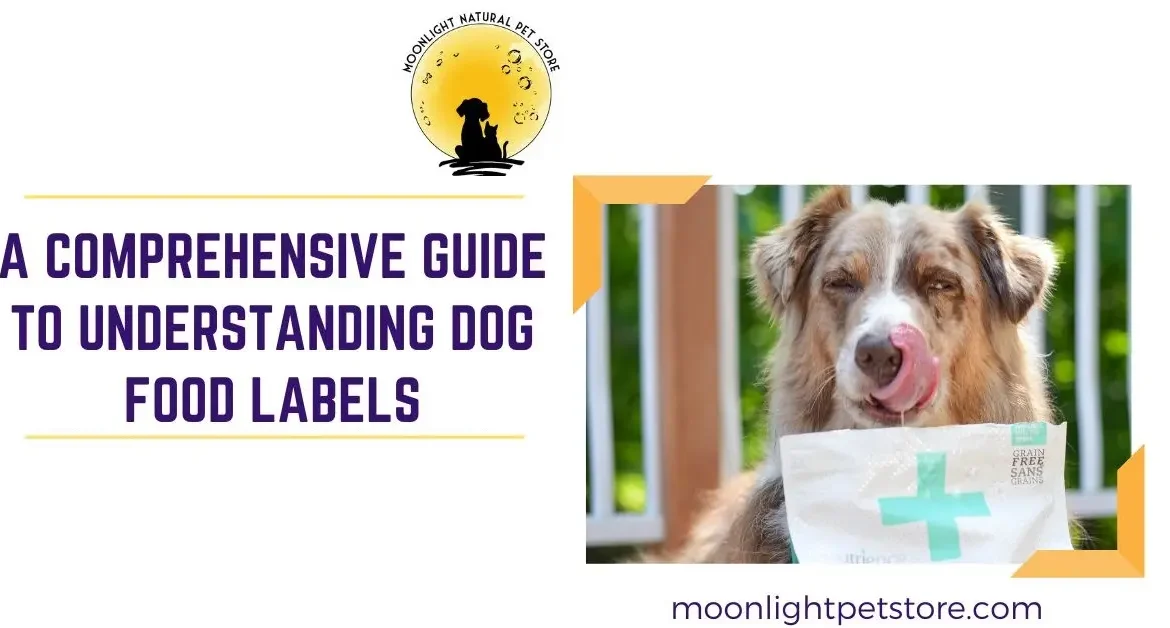
Understanding Dog Food Labels: A Complete Guide for Pet Owners
Understanding Dog Food Labels: An Introduction for Pet Owners
To any responsible pet parent, knowing that your pet is getting good food is a top priority for their health. We want our dogs and cats to live a long and healthy life and as such, it is important to understand the pet food labels. However, with the vast array of dog foods out there, we are sometimes duped by marketing and little tricks employed by pet manufacturers. This leads us to believe that what we are feeding our pet is what we think is the best for them.
Don’t worry, we’re here to help. In this comprehensive guide, we’ll provide you with all the information you need to understand dog food labels and make sure you’re selecting the right diet for your beloved pet. We’ll break it down in plain language, making it easy to identify what a good quality dog kibble food looks like. We’ll also provide insights into pet food ingredients you should avoid for your dog’s long-term health. So if you’re wondering how to make an informed decision when it comes to your pup’s nutrition, read on and get ready to learn about pet food labels.
How Does AAFCO Affect Pet Food Labels?
Here are a few important things to remember.
- The Association of American Feed Control Officials (AAFCO) Nutrient Profiles is held as the standard for how pet food should be made.
- If things do not meet AAFCO standards, pet foods are generally not considered complete or balanced. This often makes consumers think that they are the regulatory body. The FDA is the regulatory body. The AAFCO and the FDA work together.
- However, despite the fact that there is a standard, it falls short. The FDA itself stated in 2014 that “the AAFCO process ultimately falls short” and “the majority of ingredients that are included in the AAFCO ‘official publication’ are neither approved food additives nor are they generally recognized as safe (GRAS).
- AAFCO standards is the minimum for a dog to survive meaning pet foods that have it are showing the minimum nutritional adequacy statement. It is not what is required for our pets to thrive.
- To prove AAFCO statement, a pet food manufacturer could formulate the food to meet the minimum standard by using industry recognized software and not test.
- A more expensive approach is lab testing or AAFCO feeding trials where dogs are actually fed the food and results provided. This can still be manipulated as pet food manufacturers can pass AAFCO standards but it does not mean the best quality nutrition.
How to Read the Ingredients List on Dog Food Labels: A Simple Guide
First of all, the pet food label or ingredient panel behind your kibble is regulated by the Food and Drug Administration (FDA). The ingredient panel tends to be pretty standardized.
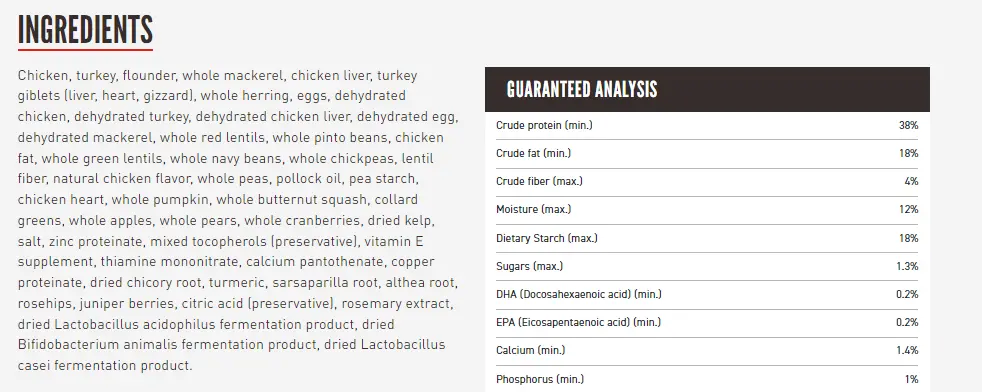
Ingredients on the label of the pet food bags are listed by weight. Therefore the first ones are the heaviest ones. A good dog kibble should always have a primary protein source as the main ingredient. Look for real meat, like chicken, beef, lamb, and fish. Avoid foods that use generic terms for animal sources like “meat by-products” or “meat meal.”
“Meat meal” is generally poor quality meat because you do not know what protein is in the meal. There are horror stories of rendering plants mixing dead cows and road kill in “Meat meal” and selling them to pet food manufacturers. We doubt that is the case but it is important to know what you are feeding your dog.
HOWEVER, when meat is put in a bag of food, it is measured by its weight when it is uncooked. This means that its moisture level is included. This allows companies to market the kibble as “meat first” when it is on a DIFFERENT WEIGHT basis from other ingredients.
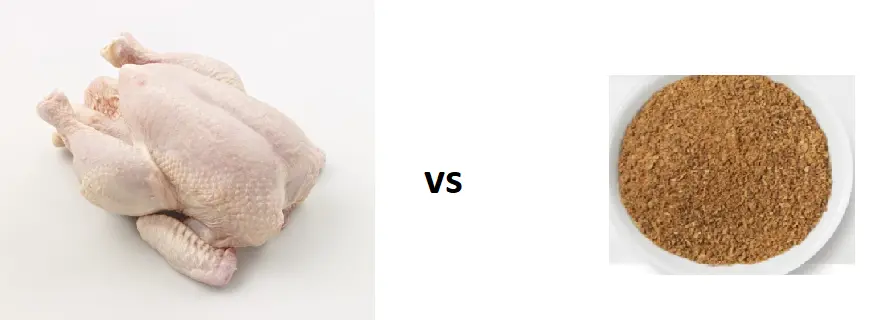
Other ingredients are already dry or cooked when they are measured by weight. A cooked meat will be lighter than uncooked meat. If the food has “Chicken meal” that means that it is already cooked and therefore dry. We consider Chicken to be fresh Chicken and better quality than Chicken Meal. Technically, the digestibility of fresh meat sources eg. chicken tends to be higher than already processed “chicken meal.” Make sure the source of the protein is from the USA, Canada or New Zealand.
Do You Need to Read Past the First 5 Ingredients on Pet Food?
YES. This is because manufacturers know you are looking at the first 5 ingredients.
Typically, the carbohydrate component is not listed on the dog food panel.
Understanding Guaranteed Analysis on Dog Food Labels: A Complete Guide
The Guaranteed Analysis (GA) is a required section on every dog food label. It offers a percentage breakdown of the key nutrients in the food, such as protein, fat, fiber, and moisture content. This information ensures that pet owners can evaluate the nutritional value of the dog food they’re purchasing, enabling them to choose a food that meets their dog’s specific dietary needs.
The Guaranteed Analysis is “guaranteed” by the manufacturer, meaning the percentages listed must meet or exceed the amounts stated on the label. It’s important to remember that this analysis provides a general overview of the food’s nutrient content but doesn’t give specific details about the exact ingredients or how well the nutrients are absorbed by your dog.
Key Components of Guaranteed Analysis for Dog Food Labels
The Guaranteed Analysis typically includes the following key nutrients:
- Crude Protein:
- Why it’s important: Protein is essential for muscle maintenance, tissue repair, and overall body function. Dogs require different amounts of protein depending on their age, activity level, and health status.
- What to look for: The GA will list the percentage of crude protein, which represents an estimate of the protein content in the food.
- Crude Fat:
- Why it’s important: Fat is an energy-dense nutrient that supports skin and coat health, brain function, and overall energy levels.
- What to look for: The percentage of crude fat will tell you how much fat is in the food. Look for a healthy balance—too little fat may lead to poor coat condition and low energy, while too much fat can lead to obesity or may affect pets with pancreatitis.
- Crude Fiber:
- Why it’s important: Fiber can help with digestion.
- What to look for: The right amount of fiber should keep your dog’s digestive system healthy and functioning properly.
- Moisture Content:
- Why it’s important: The moisture content indicates the amount of water in the dog food.
- What to look for: Dry dog food typically contains about 10-12% moisture, while canned foods can have 70% or more. If you feed your dog dry food, ensure they are drinking enough water to stay hydrated.
Carbohydrates though have been omitted. However, this is an important consideration to figure out what is a good quality kibble versus a poor quality kibble.
To figure out the carbohydrate, use the following calculation below.
Dry Matter = 100% – Moisture % (This is all of the food without any moisture).
Carbohydrate (Dry Matter) = 100% – [(Protein+Fat +Fibre)/ Dry Matter] – Ash (Dry matter basis)
For Ash (dry matter), use 8%, which is average if not on bag. Ash refers to the inorganic minerals left if all the organic content is burnt off.
Generally, when the carbohydrate on a dry matter basis is above 35%, the kibble is considered a low quality kibble. This is because carbohydrates tend to be cheaper ingredients. Storage, packaging and transportation of carbohydrates which tend to be dry goods are all lower. Thus more carbohydrates in kibble means more profit for manufacturers. We’ve seen arguments for the inclusion of carbohydrates as a good source of calories, fiber, antioxidants and vitamins. However, that twists the argument. Anywhere between 1 in 100 to 1 in 500 cats as well as dogs develops diabetes, and this is expected to increase!
In 2023, the AAFCO came out with new rules which now say that Pet Food Manufacturers are required to include Total Carbohydrates (max)%: calculated value as well as the Dietary Fiber (max)% which replaces the Crude fiber.
Despite dogs being adaptable to carbohydrates, it does not mean that they should have them in large quantities. They can get all the required nutrition from the inclusion of meat which is more biologically appropriate.
From our example pic above:
| Ingredient Panel | Dry Matter = 100 – Moisture % | Carbohydrate (Dry Matter Basis) = 100% – [(Protein+Fat+Fibre)/ Dry Matter ]- Ash (dry matter) | Carb (dry matter) = > 35%? | |
| Dog Kibble Brand 1 | 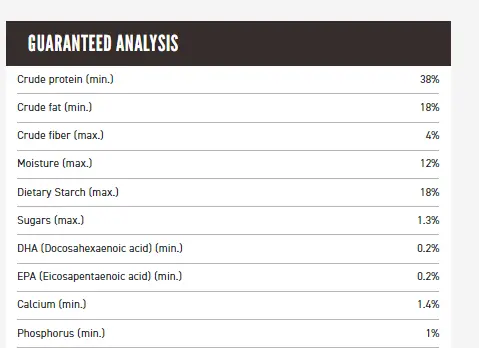 | 100-12= 88% | 100 – [(38+18+4)]/88 -8 = 23.8% | Better quality kibble |
| Dog Kibble Brand 2 | 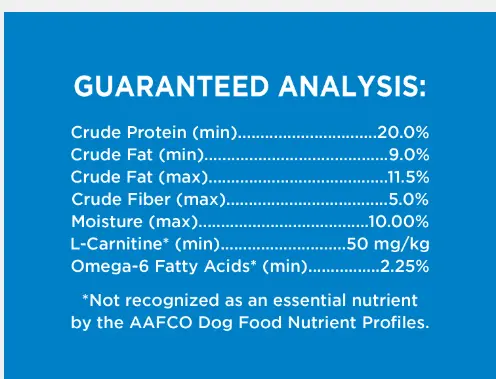 | 100-10= 90% | 100-[(20+9+11.5)]/90 -8 = 47% | Lower quality kibble |
Splitting of Pet Food Ingredients
Some manufacturers split ingredients or use similar ingredients to hide by weight where certain ingredients should fall on the panel.
Remember that ingredients on any pet food bags are listed by weight and the first ones are the heaviest ones. Since manufacturers know you are looking at the first 5 ingredients, they may split ingredients. For example, on your kibble ingredient list do you see peas, chickpeas listed in different places? What about potato, sweet potatoes or brown rice, white rice or rice flour? These are similar items and if you combined them might actually weigh more than the first one.
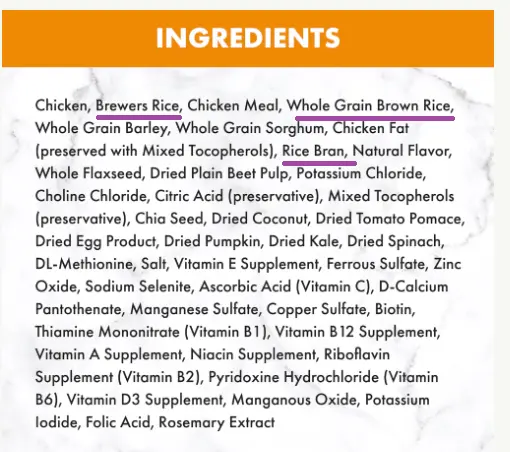
If you add Brewers Rice, Whole Grain Brown Rice and Rice Bran, you’d see that Rice should likely be the first ingredient. This can be used to hide the weight of ingredients as manufacturers know that pet owners are busy and will read only the first few ingredients.
Salt Divider Rule & Use in Pet Food Labels
The Salt Divider rule is a good tool to figure out if your pet food manufacturer is engaging in deceptive marketing. AAFCO recommends that salt in pet food should constitute at least 0.2 % of cat food and 0.3% of dog food.
Let’s take an example of a pet food ingredient panel, below and we’ll circle the ‘salt.’

Are fruits and veggies listed after salt? Assuming they are, that means if your dog kibble is 25 lbs or 11. 3 kg then approximately 0.3% or less would be about 34 g of a particular vegetable or fruit. This is essentially a sprinkle.
In our example above, here is the picture used for the kibble. You’ll see that fresh carrots are marketed on the bag of food. However, if you look at the ingredient panel above, you’ll realize that the ingredients talk about dried carrots not fresh. Secondly, the amount included in the bag is less than 0.3% of the dog food. In addition, deboned chicken does not look like grilled chicken breast. This is Marketing! They also seem to have used deboned chicken which has moisture so that they can market “Real Chicken as #1” ingredient but add chicken meal as well probably in order to reduce the cost of using fresh chicken only.
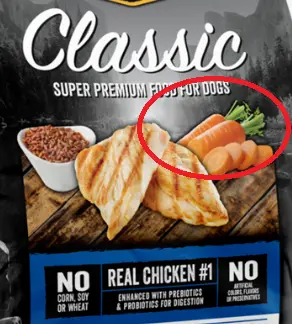
Vitamins and Mineral Supplementation in Pet Food
Typically, most pet parents assume that the more vitamins and minerals they see on the bag of kibble, the better the food is. This is FALSE.
In actuality, extrusion results in loss of vitamin A, B, C and some minerals. In our blog choosing the best dog kibble, we talk about the impact of high temperatures on depleting lysine, taurine, fatty acids, enzymes.
Pet manufacturers add back supplements from synthetic sources due to the damage caused by high heat. Quote below from Popular Science – The Chemistry of Kibble.

It is cheaper for pet manufacturers to use vitamin and mineral supplement packs than to use better ingredients.
2 types of supplements are used:
(1) Chelated minerals known as proteinates on the ingredient panel, are easier for the body to absorb but more expensive.
(2) Inorganic compounds like sulfates, iodates are not as easily absorbed but cheaper for the manufacturer.
In addition, to compensate for amino acids damaged, left chain molecules of amino acids such as DL- Methionine are added. Left-Chain molecules of amino acids don’t work the same way as the real amino acid. DL-Methionine is used when there is not enough good-quality meat or fish in food or used as a palatant.
Better brands will also use mostly proteinates. Better brands use no or less synthetic ingredients including vitamins and minerals. Less chemically synthetized supplements = less burden to their bodies.
By understanding what to look for in the ingredient list, you can make sure that your pup’s kibble is providing them with the nutrition they need.
Questionable Ingredients Used in Dog Kibble
We’ve seen lists on other websites that talk about questionable ingredients used in kibble manufacturing. However, we found that most of the lists are not practical. For example, other websites will talk about avoiding ingredients and preservatives that can be possible carcinogens (cancer causing) or can damage the liver and kidneys. The idea is good. These include
- Butylated Hydroxyanisole BHT
- Butylated Hydroxytoluene BHA
- Ethoxyquin,
- Nitrites & Nitrates,
- Sodium Tripolyphosphate,
- Menadione,
- Proplyene Glycol,
Here’s the problem. It is hard to find a pet food manufacturer dumb enough to include any of these in their pet food labels. It would be shooting themselves in the foot as they know that pet parents are looking for these ingredients. And if you find a pet manufacturer that puts this on their label, then they just don’t respect your intelligence.
With the exception of the Menadione, it is pretty difficult to find the others on any self-respecting dog manufacturer’s ingredient panel or one that wants to stay in business.
Our Naughty Ten Pet Food Ingredients to Avoid in Dog Kibble
Problems with Ingredient Labelling of Pet Food
Although the ingredient panel is useful for giving you a standardized list by weight of the ingredients.
- It does not tell you anything about the quality of the ingredient or the sourcing of the pet food. For example, “Chicken” means fresh chicken but it does not tell you how Fresh is the chicken. It also does not tell you if the chicken is free range, non-medicated. Neither does it tell you if it is a USA product or imported from China.
- The ingredient panel also does not tell you how much of each ingredient is in the product. By weight, we know the ranking in a panel. For example, in a panel “Chicken, Peas, White Rice, Pea Protein.” We know what comes first but we don’t know if Chicken is 20%, Peas 18%, White Rice 15%, Pea Protein 10%.
- If our example is plausible, then technically, the first ingredient is Pea +Pea Protein =18%+10%= 28% and Chicken which has moisture will move down.
- The manufacturer window dressed ingredients to move pea protein which is not as desirable down in the list.
What Else Should You Know About Guaranteed Analysis?
Similarly the Guaranteed Analysis, does not provide enough information as it is shown on an “as is”/”as fed” basis. For comparisons across brands, you would have to take the moisture out and convert to a dry matter.
In 2023, AAFCO update the labelling rules and suggested that organically produced ingredients may be identified as organic in the label.
You’d do the same math for a pet food can so that you can compare the protein in the canned food to the protein in a kibble for example.
In addition the calories shown do not tell you how the energy is distributed from protein, carbohydrates or fat.
Lastly, crude protein on pet food is not exactly protein. It figures out the nitrogen amount in the food and multiplies it by a factor.
Canine DCM and Grain-containing versus Grain-Free Diets
We’ve been hearing of vets asking dog and cat owners to add grains to their pet’s food due to canine heart disease or food-related Dilated Cardiomyopathy (DCM).
Unfortunately, these vets seem to be behind the news and giving customers a worrisome knee jerk reaction.
We wrote in 2020 about how the FDA erred in 2018 and announced that ONLY grain-free kibble were linked to dilated cardiomyopathy.
Since then, the FDA has backpedaled and said that they are not sure what is causing non-hereditary DCM. Having grains in the food or not is not reason for DCM.

They acknowledge that they are unsure what the cause of DCM is. Adding grains to your pet food will not fix the issue. The FDA stated that it will not publicly speak on the potential links between Canine DCM until it has enough CAUSAL not Spurious data.
An investigation by journalists in July 2022 found that the “veterinarians who prompted the FDA to consider diet have financial and other ties to the leading sellers of grain-inclusive pet foods.”

I wrote in May 2020 that the study was flawed as it was biased toward only grain-free foods. In the article, the journalists found that one of the vets instructed grain-free foods to be reported only to the FDA. The FDA however in response to the article said they never requested for DCM cases to be limited to only certain diets.
- Choose a good whole foods-based dog food and rotate your proteins.
- Add seafood to your pet’s meal once a week or omega-3 fatty acids
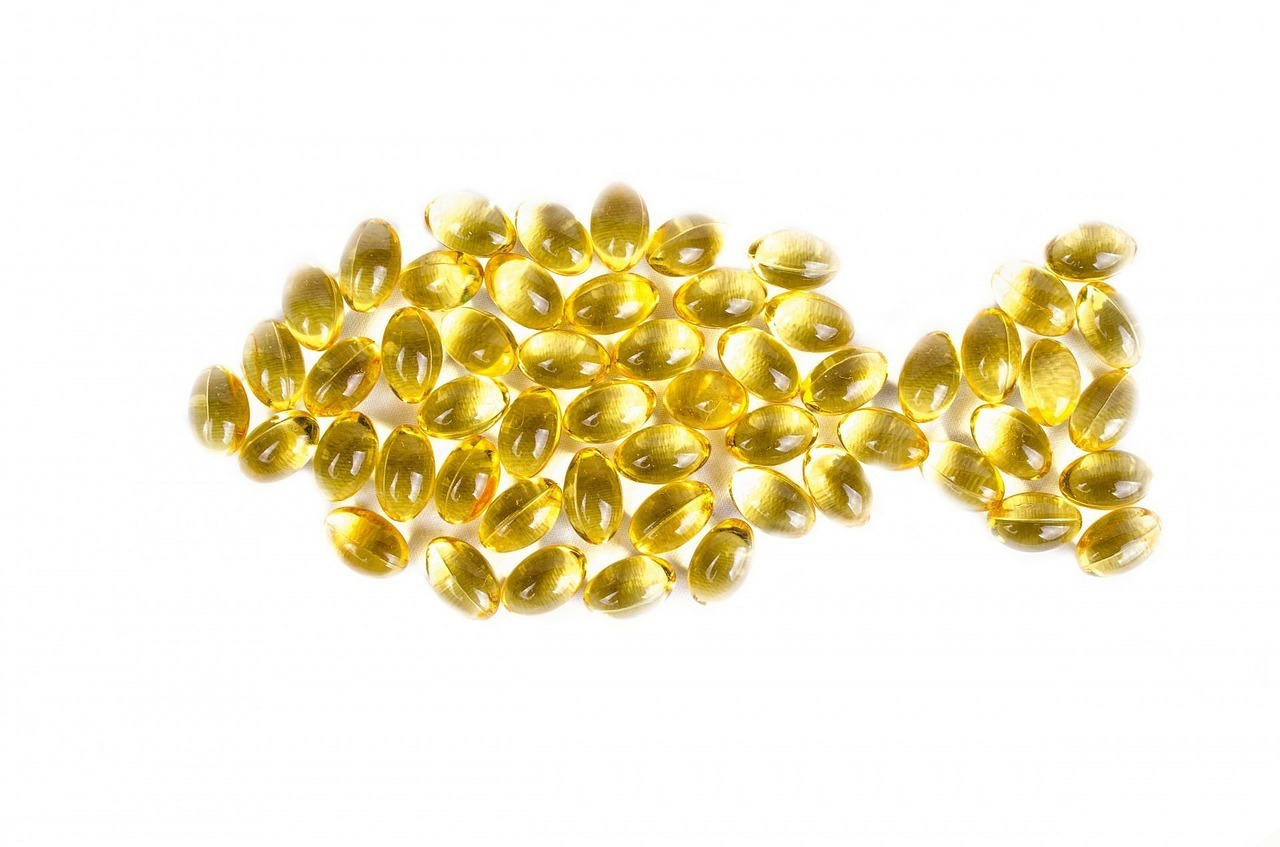 .
.
Conclusion
For all pet parents, we suggest learning how to read the pet food label as the first step in educating yourself about your dog or cat’s kibble.
Although there are limitations on what the dog food label tells you, it is the first step to not being gamed by pet food manufacturers. Although AAFCO, does not allow for digestibility to be included, this should be something that all pet food manufacturers should provide at least on their websites.
We hope you join us in requesting your kibble manufacturer provide more information about protein digestibility.
Remember to rotate your dog’s proteins and pet food brands. Yes, a dog can eat the same thing for a long time but that does not mean they should.
Let us know if you have an thoughts or questions. Either way, leave a comment below right now.


